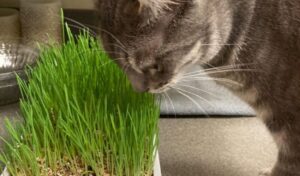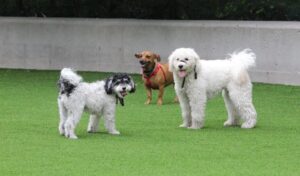While real grass provides natural sensory stimulation and is environmentally friendly, it also requires maintenance and upkeep and can be prone to damage from dogs’ urine. On the other hand, fake grass is low maintenance and long-lasting, but lacks the natural sensory stimulation of real grass and may require an initial investment. Ultimately, the decision between real and fake grass for dogs comes down to personal preference and consideration of the factors that are most important to you and your furry friend.
Advantages and Disadvantages of Real Grass for Dogs
Advantages
- Natural and organic
- Provides sensory stimulation
- Environmentally friendly
- Promotes better health for dogs
Disadvantages
- Requires maintenance and upkeep
- Can cause allergies
- May attract pests and insects
- Prone to damage from dogs’ urine

Advantages and Disadvantages of Fake Grass for Dogs
Advantages
- Low maintenance and upkeep
- Durable and long-lasting
- Non-toxic and safe for pets
- Consistent appearance and cleanliness
Disadvantages
- Lack of natural sensory stimulation
- Potential heat retention
- May require initial investment
- May need to be replaced after several years

Factors to Consider When Choosing Between Real and Fake Grass for Dogs
- Maintenance: Real grass requires more maintenance, such as mowing, watering, and fertilization, compared to fake grass. Consider whether you have the time, resources, and willingness to take on the necessary maintenance tasks.
- Sensory Stimulation: Dogs enjoy the sensory stimulation of real grass, including the smells, textures, and natural feel under their paws. Consider whether providing this sensory experience is important for your dog’s overall well-being.
- Durability: Fake grass is more durable and long-lasting than real grass, but it may need to be replaced after several years due to wear and tear. Consider the expected lifespan of each option and weigh the long-term costs.
- Environmental Impact: Real grass is environmentally friendly, contributing to air quality, carbon sequestration, and soil health. Consider the impact on the environment of your chosen option.
- Health: Both real and fake grass can promote better health for dogs by offering opportunities for exercise, fresh air, and mental stimulation. However, real grass may attract pests and insects that can carry diseases harmful to dogs, while fake grass may retain heat and become uncomfortably hot for dogs during the summer months.

Maintenance and Upkeep for Real and Fake Grass
Maintenance and upkeep are important considerations when deciding between real and fake grass for dogs.
Real grass requires regular maintenance, such as mowing, watering, and fertilization, to keep it healthy and looking good. Depending on the size of your lawn and the type of grass, this can be a time-consuming and labor-intensive task. You will need to mow the grass regularly to keep it at the appropriate height, water it frequently to keep it healthy and green, and fertilize it to promote growth and prevent weeds.
Fake grass, on the other hand, requires minimal maintenance. You don’t need to mow or water it, and it doesn’t require fertilization or weed control. You may need to rinse it off occasionally to remove debris or pet waste, but overall, it is much easier to care for than real grass.
Both real and fake grass may require occasional repairs due to wear and tear. With real grass, you may need to reseed or patch areas that have been damaged by dogs’ urine or heavy foot traffic. With fake grass, you may need to replace damaged sections or repair seams.

Installation Considerations
Real grass requires significant preparation and installation. The ground needs to be properly graded and leveled to ensure proper drainage and avoid water pooling. You may need to remove existing vegetation, rocks, and debris to prepare the soil. Then, you will need to select the appropriate type of grass seed or sod, install it properly, and water it frequently to promote growth.
Fake grass, on the other hand, requires less preparation and can be installed relatively quickly. The ground should still be graded and leveled, but there is no need to remove existing vegetation or prepare the soil for planting. Instead, the fake grass can be rolled out on top of a layer of crushed stone or sand, which helps with drainage and stabilization.
When installing fake grass, it is important to select the right type for your specific needs. Consider the pile height, backing material, and drainage system to ensure that the fake grass is durable and long-lasting.
Overall, the installation process for real grass requires more time, effort, and resources, while fake grass can be installed quickly and with minimal preparation.

Environmental Considerations
Real grass has several environmental benefits. It helps to reduce carbon dioxide levels, which can contribute to climate change, by absorbing carbon and releasing oxygen through photosynthesis. It also helps to prevent soil erosion, improve soil quality, and promote biodiversity by providing habitat for insects and wildlife.
However, real grass also requires water, fertilizers, and pesticides, which can have negative environmental impacts. Overuse of water can contribute to droughts, while excess fertilizer and pesticide runoff can pollute waterways and harm aquatic life. The production and transportation of grass seed and sod can also contribute to greenhouse gas emissions.
Fake grass, on the other hand, requires no watering, fertilizers, or pesticides, which can reduce environmental impact. However, it is made from synthetic materials that are non-biodegradable and can contribute to landfill waste. The manufacturing and transportation of fake grass can also contribute to greenhouse gas emissions.
To minimize the environmental impact of your choice, consider opting for real grass that is grown sustainably, using organic fertilizers and pest control methods. Alternatively, choose fake grass made from recycled materials or choose a product that is recyclable at the end of its lifespan. Ultimately, the most environmentally friendly option will depend on a variety of factors, including location, climate, and personal values.
Health Considerations for Dogs
Real grass can provide several health benefits for dogs. It allows them to exercise, play, and explore in a natural environment that provides mental and physical stimulation. Real grass can also help to reduce stress and anxiety in dogs and promote healthy digestion if they graze on it.
However, real grass can also present health risks for dogs. Pesticides and fertilizers used to maintain real grass can be toxic if ingested or absorbed through the skin. Real grass can also harbor ticks, fleas, and other parasites that can pose health risks to dogs. Additionally, some dogs may be allergic to certain types of grass, causing skin irritation or respiratory problems.
Fake grass, on the other hand, does not require the use of pesticides or fertilizers and is less likely to harbor parasites or allergens. However, it may not provide the same level of sensory stimulation and mental enrichment that real grass does.
Overall, both real and fake grass can have health benefits and risks for dogs, and it is important to consider these factors when making a decision. If you choose real grass, consider using organic and non-toxic methods for maintenance and pest control. If you choose fake grass, consider providing other forms of enrichment, such as toys and puzzles, to promote mental and physical health for your dog.
Conclusion
Choosing between real and fake grass for dogs requires careful consideration of several factors. Real grass can provide sensory stimulation and environmental benefits, but requires maintenance and can pose health risks to dogs. Fake grass is low-maintenance and can be environmentally friendly, but may not provide the same level of mental and physical stimulation for dogs.
When making a decision, it is important to consider factors such as your dog’s health, your location and climate, and your personal values regarding environmental impact and maintenance requirements. Regardless of your choice, proper maintenance and care can help to ensure a healthy, safe, and enjoyable outdoor environment for your furry friend.
Ultimately, the decision between real and fake grass for dogs will depend on individual circumstances and preferences. By considering the advantages and disadvantages of each option, as well as the various factors to consider, you can make an informed decision that is best for you and your dog.
